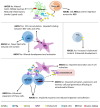Emerging Role of ABC Transporters in Glia Cells in Health and Diseases of the Central Nervous System
- PMID: 38727275
- PMCID: PMC11083179
- DOI: 10.3390/cells13090740
Emerging Role of ABC Transporters in Glia Cells in Health and Diseases of the Central Nervous System
Abstract
ATP-binding cassette (ABC) transporters play a crucial role for the efflux of a wide range of substrates across different cellular membranes. In the central nervous system (CNS), ABC transporters have recently gathered significant attention due to their pivotal involvement in brain physiology and neurodegenerative disorders, such as Alzheimer's disease (AD). Glial cells are fundamental for normal CNS function and engage with several ABC transporters in different ways. Here, we specifically highlight ABC transporters involved in the maintenance of brain homeostasis and their implications in its metabolic regulation. We also show new aspects related to ABC transporter function found in less recognized diseases, such as Huntington's disease (HD) and experimental autoimmune encephalomyelitis (EAE), as a model for multiple sclerosis (MS). Understanding both their impact on the physiological regulation of the CNS and their roles in brain diseases holds promise for uncovering new therapeutic options. Further investigations and preclinical studies are warranted to elucidate the complex interplay between glial ABC transporters and physiological brain functions, potentially leading to effective therapeutic interventions also for rare CNS disorders.
Keywords: ABC transporter; ABCA1; ABCA7; ABCB1; ABCC1; Alzheimer’s disease; EAE; Huntington’s disease; MDR1; MRP1; P-gp; astrocyte; demyelination; glia; metabolic diseases; microglia; multiple sclerosis; neurodegeneration; neuroinflammation; oligodendrocyte; rare diseases; steroid hormones.
Conflict of interest statement
The authors declare no conflicts of interest.
Figures






References
-
- Thakur K.T., Albanese E., Giannakopoulos P., Jette N., Linde M., Prince M.J., Steiner T.J., Dua T. Neurological Disorders. In: Patel V., Chisholm D., Dua T., Laxminarayan R., Medina-Mora M.E., editors. Mental, Neurological, and Substance Use Disorders: Disease Control Priorities. 3rd ed. Volume 4 International Bank for Reconstruction and Development/The World Bank; Washington, DC, USA: 2016.
-
- Feigin V.L., Nichols E., Alam T., Bannick M.S., Beghi E., Blake N., Culpepper W.J., Dorsey E.R., Elbaz A., Ellenbogen R.G., et al. Global, regional, and national burden of neurological disorders, 1990–2016: A systematic analysis for the Global Burden of Disease Study 2016. Lancet Neurol. 2019;18:459–480. doi: 10.1016/S1474-4422(18)30499-X. - DOI - PMC - PubMed
-
- Katzeff J.S., Kim W.S. ATP-binding cassette transporters and neurodegenerative diseases. Essays Biochem. 2021;65:1013–1024. - PubMed
Publication types
MeSH terms
Substances
Grants and funding
LinkOut - more resources
Full Text Sources

